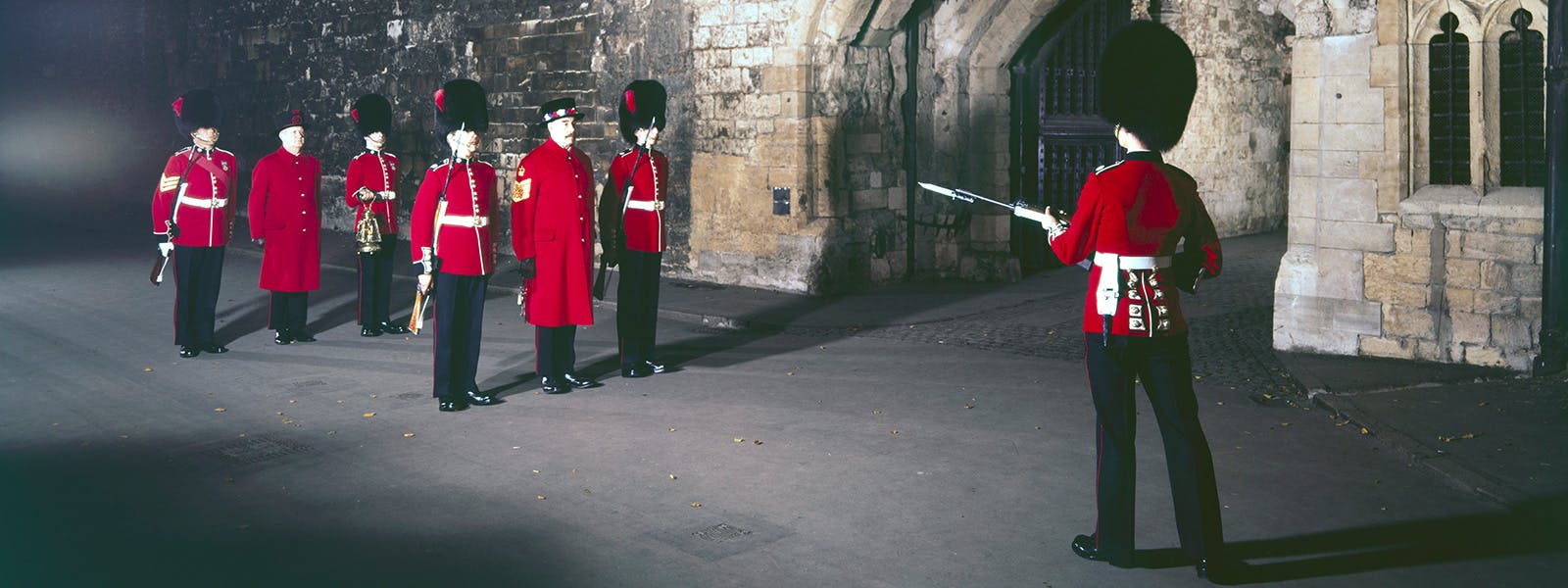
Discover this and other centuries-old traditions of the Tower of London
While the Tower remains a living fortress, changing and adapting as times demand, it still maintains centuries of colourful traditions.
Best known among them is the ceremonial locking and unlocking of the gates of the fortress, which has taken place for centuries, and has become known as The Ceremony of the Keys.
Among other popular traditions are the impressive Gun Salutes on the Wharf, the Constable's Dues and the ancient Beating of the Bounds.

Image: The Chief Yeoman Warder, carrying the keys, is escorted by solders during the ceremony. © Historic Royal Palaces
'Halt! Who comes there?’
This the time-honoured challenge that has been barked out by a soldier guarding the Tower, nearly every night for seven centuries.

Image: King Edward III by an unknown artist, © National Portrait Gallery, London
How it all began
The formal locking and unlocking of the Tower gates started in the mid 1300s, on the orders of a furious Edward III. The King turned up unannounced at the Tower one night in December 1340 and walked straight in, unchallenged!
After imprisoning the Constable of the Tower, Edward de la Beche, for dereliction of duty, Edward decreed that the castle should be locked at sunset and unlocked at sunrise.
The King was also inspired to carry out a thorough review of security and generally improve the Tower’s rather neglected state. Edward III ordered the Sheriffs of London to contribute £40 to improvements at the Tower, around £30,000 in today’s money!

Image: Queen Mary I by Master John, 1544, © National Portrait Gallery, London
Following orders
A nervous Mary I (r1553-8) was keen to improve security at the Tower as she grew increasingly unpopular. In 1555, after the failed Protestant plot and execution of Lady Jane Grey, the Queen ordered the Constable of the Tower to beef up the Beefeaters. The Constable was to ensure that there should be no fewer than 21 ‘discreet, trusty and personable yeomen of middle age, none above 50 or below 30’.
Mary also decreed that nine Yeoman Warders were to patrol during the day, and six at night. Detailed instructions were also laid down for securing the keys at night. The original text describes the form of the ceremony that has been performed nearly every night since:
‘And it is ordered that there shall be a place appointed under Locke and key where in the keys of the gates of the saide Tower shall be laide in the sight of the constable, the porter and two of the Yeoman Warders, or three of them at the least, and by two or three of them to be taken out when the[y] shall be occupied. And the key of that locke or coffer where the keys be, to be kepte by the porter or, in his absence, by the chief yeoman warder.’
Changing times
In 1826, the Duke of Wellington, then Constable of the Tower, ordered that the time of the ceremony should be fixed at 10pm, rather than the more vague ‘sunset’.
This was to ensure that all his soldiers stationed at the Tower were inside the walls before the gates were locked.
The story goes that the only time the ceremony has ever been disrupted was when a bomb fell on the Tower on 29 December 1940. The Chief Yeoman Warder was blown off his feet, but otherwise unhurt.
Did you know?
When everyone had dusted themselves down after the bombing, the ceremony continued, although slightly later than usual.
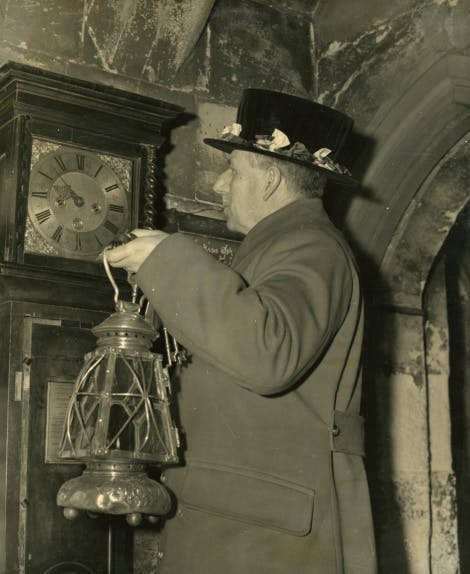
Image: Chief Yeoman Warder, A H Cook, lantern and keys in hand, checks the time in preparation for the start of the ceremony in 1947, © Historic Royal Palaces/Yeoman Warder Archive
What happens at the Ceremony?
Since 1826, at exactly seven minutes to ten at night, the Chief Yeoman Warder of the Tower emerges from the Byward Tower, wearing the traditional red Watch Coat and Tudor Bonnet. In one hand, he carries a lantern, still lit to this day with a single candle. In the other he carries a set of keys – the King’s Keys.
He proceeds at a dignified pace to the archway of the Bloody Tower, where an escort is formed in readiness. This escort is made up of soldiers from the military garrison at the Tower. It comprises two sentries, a sergeant and another guard who represents the role of drummer (but who actually plays a bugle).

Image: The Chief Yeoman Warder locking the gates of the Byward Tower in 1930 © Historic Royal Palaces
Locking up
The Chief Yeoman Warder then hands the lantern to the drummer and they all march to the outer gates of the Tower.
The Chief, assisted by the Tower’s Watchman, closes, locks and secures the outer gates, while the escort stand guard. The same process takes place at the inner gates.

Image: The Ceremony of the Keys, showing the conclusion of the ceremony with the Chief Yeoman Warder saluting the Queen's Guard in 1968. © Historic Royal Palaces
As the clock strikes 10
The Chief Yeoman Warder moves two paces forward, raises his Tudor bonnet high in the air and says: ‘God preserve King Charles’.
The guard answers ‘Amen’, exactly as the clock chimes ten, the soldier representing the drummer sounds 'The Last Post' on a bugle.
The Chief Yeoman Warder takes the keys back to the King's House, to hand them back to the King’s representative at the Tower, The Resident Governor, and the Guard is dismissed.
Naturally, the wording changes depending on the monarch, as does the title of the King’s/Queen’s House.

Book tickets to the Ceremony of the Keys
Be part of this ancient tradition, which has taken place every night for at least 700 years in the Ceremony of the Keys at the Tower of London.
Beating the Bounds
The area around the Tower, including Tower Hill, known as the Tower Liberty, is controlled by the Tower but its borders have been disputed with the City of London for centuries. It is marked by boundary stones and every three years on Ascension Day, local children and officials walk the streets around the Tower and beat the stones with willow wands.
Beating the Bounds is not exclusive to the Tower Liberty. It’s an ancient custom, still observed in many English parishes. It has roots in parishes re-affirming their boundaries, stopping at each boundary mark to beat the stones with willow wands. Prayers would be said for protection and blessing for the land.
Did you know?
This ceremony dates back to a 14th-century tradition that boys were actually beaten at the stones so they would remember their location!

Image: This photograph from 1957 shows choirboys beating a boundary stone. © Historic Royal Palaces
Record beating
The church of All Hallows, next to the Tower of London, observes a bound-beating ceremony every year.
However, every third year the ceremony includes a ‘battle’ with the Resident Governor of the Tower and Yeoman Warders at the boundary mark shared by the Tower and the church.
This commemorates an occasion in 1608 when a riot took place between the people of the Tower and the people of the Church.
Today, the tri-annual encounter only involves an exchange of words.
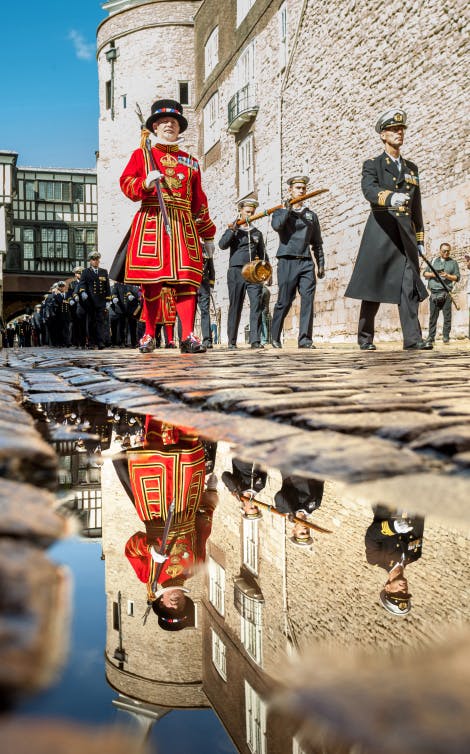
Image: The Captain and crew of the Dutch naval ship ‘HNLMS Johan de Witt’ take part in the unique and colourful Ceremony of the Constable’s Dues at the Tower of London. © Historic Royal Palaces
The Constable's Dues
The ‘Dues’ are one of several perks that the Constable of the Tower traditionally enjoyed.
Every ship that came upstream to the City had to moor at Tower Wharf to unload a portion of its cargo for the Constable.
Still today, whenever a Royal Naval vessel moors on the Wharf, the Captain must present the Constable with a barrel of wine (the ‘Dues’).
This is ceremoniously escorted into the Tower by the Yeoman Warders and presented to the Constable on Tower Green.
Other tariff once extracted from Londoners included any horse, oxen, pigs or sheep that fell off London Bridge!

Image: Naval officers from 'HMS Richmond' deliver the barrel to the King's House (then the Queen's House) during a Constable's Dues ceremony on 15 May 2017. © Historic Royal Palaces
Roll out the barrel
The Constable's Dues has never become just a symbolic ceremony.
Once delivered to the King's House the barrel is opened and the wine enjoyed!
Gun salutes
One of the first recorded royal salutes to be fired from the Tower of London was on Whit Sunday 1533 to mark the coronation of Anne Boleyn, King Henry VIII’s second wife.
Since then, gun salutes have marked a variety of occasions including the Union of Great Britain and Ireland in 1800 and the opening of Tower Bridge in 1894.
Did you know?
A basic salute is 21 rounds, but because the Tower is a royal palace, an extra 20 rounds are fired.

Image: Tower Wharf, showing the Honourable Artillery Company (HAC) 62-gun salute to mark the 70th anniversary of Queen Elizabeth II's accession to the throne on 6 February 1952. © Historic Royal Palaces
Loud and proud
Today, 62-gun salutes are fired for royal occasions, including King Charles III's birthday and on the anniversary of his accession to the throne, and 41-gun salutes are fired at the State Opening of Parliament.
Royal births are always celebrated and gun salutes were fired for Prince George in 2013, Princess Charlotte in 2015 and Prince Louis in 2018. A total of 62 rounds are fired, and the total time is around ten, deafening, minutes!
Browse more history and stories
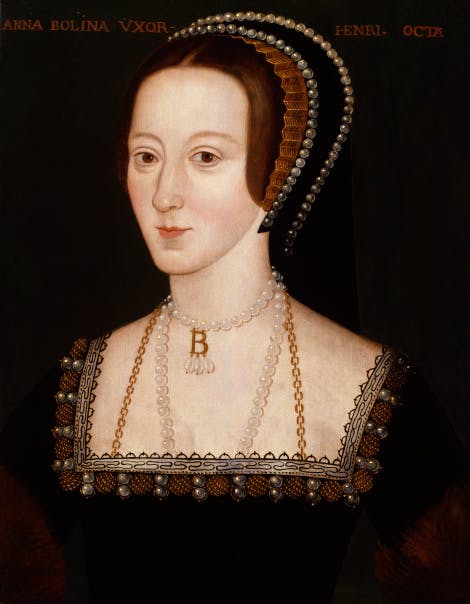
Anne Boleyn
How did Anne Boleyn become queen and why did Henry VIII execute her?
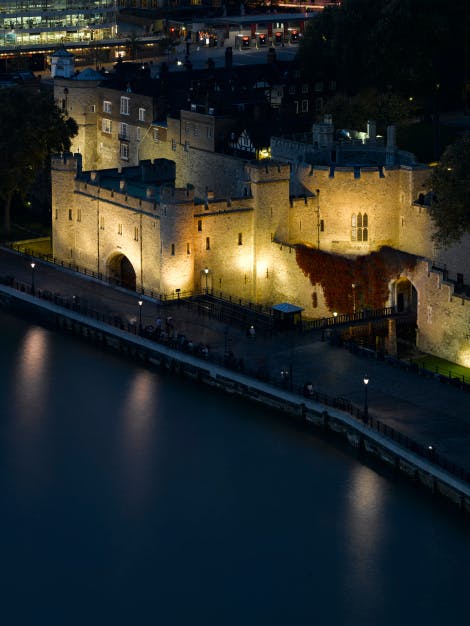
The story of the Tower of London
Iconic fortress, royal palace and infamous prison.

Arbella Stuart
From contender for the throne to prisoner in the Tower of London
Explore what's on

- Things to see
Battlements
Walk the defensive walls and huge towers that have guarded the Tower of London for centuries.
- Open
- Tower of London
- Included in palace admission (Members go free)

- For members
- Events
Members-only Ceremony of the Keys
Members-only access to the traditional locking up of the Tower of London, the Ceremony of the Keys.
-
18 January, 08 February, 22 March 2026
- 21:30
- Tower of London
- Separate ticket (advance booking required)

- Tours and talks
Ceremony of the Keys
Be part of this ancient tradition, which has taken place every night for at least 700 years in the Ceremony of the Keys at the Tower of London.
-
Daily (next ticket release 05 January 2026)
- From 21:30-22:05
- Tower of London
- Separate ticket (advance booking required)
Shop online

Shop Hanging Decorations
Browse through our beautiful range of hanging decorations, ornaments and baubles including unique and hand-made pieces.
From £5.50

Tower of London Navy Raven Sweatshirt
Inspired by the infamous ravens of the Tower of London, this sweatshirt will keep you warm on those chilly days.
£38.00

Shop Six Wives of Henry VIII
'Divorced, Beheaded, Died: Divorced, Beheaded, Survived' - this best selling range is as colourful as it is informative.
From £15
